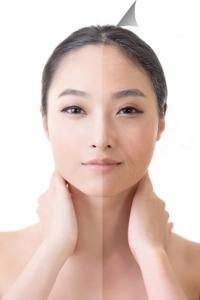Aging is determined by many factors besides the date of birth, but cellular senescence can be an important element of aging and age-related diseases. Several physiological and pathological conditions are subjects of aging research, including senescence, direct aging, photoaging, oxidative, mitochondrial, and inflammatory aging, among others.
Schisandrin B and its analogue, schisandrin C, were shown to protect human foreskin fibroblasts against oxidative damage induced by artificial solar light. These substances were proposed to be used in the prevention of skin photoaging. They exerted a protective effect by the stimulation of the production of reduced glutathione, decreased expression of matrix metalloproteinase 1, and an elastase-type protease. However, these compounds also produced ROS (reactive oxygen species) during their metabolism, mediated by the cytochrome P-450, and this reaction likely provoked potentiated antioxidant response by the glutathione system.
Similar results were obtained for schisandrin B in the human keratinocyte-derived cell line HaCaT. Schisandrin B reduced the cell death, DNA damage, and oxidation of proteins in these cells challenged by oxidative stress; and increased the expression of key enzymes of the antioxidant defence and stimulated the Nrf2 (nuclear factor erythroid 2-related factor 2) and MAPKs (mitogen activated protein kinases) pathways. Similar effects were observed for deoxyschisandrin and schisandrin B in HaCaT keratinocytes exposed to UVB. Altogether, these effects were concluded to be important in the prevention of skin aging underlined by oxidative stress.
Osteoarthritis (OA) is a joint disease, affecting the middle-aged to elderly. An ethanol extract of schisandra chinensis was shown to exert a protective effect against cartilage degradation in a monosodium iodoacetate (MIA)-induced OA model. This protection was underlined by a reduced production of inflammatory cytokines and tumor necrosis factor-alpha (TNFα), an inhibited expression of inducible nitric oxide synthase and cyclooxygenase-2, and increased levels of matrix metalloproteinase-13, cartilage oligomeric matrix protein, and a C-telopeptide of type II collagen.
 Sarcopenia, a progressive loss of muscle strength and mass with aging, is commonly considered as an important indicator of normal aging and occurs in some diseases associated with accelerated aging. Schisandra chinensis was shown to increase mass of skeletal muscle treated by dexamethasone or that underwent sciatic neurectomy. Schisandra chinensis ameliorated muscle atrophy by increased protein synthesis resulting from downregulation of the mTOR/p-4E-BP1 (4E-binding protein1)/p-P70S6K (70 kDa ribosomal protein S6 kinase) pathway in human myoblasts.
Sarcopenia, a progressive loss of muscle strength and mass with aging, is commonly considered as an important indicator of normal aging and occurs in some diseases associated with accelerated aging. Schisandra chinensis was shown to increase mass of skeletal muscle treated by dexamethasone or that underwent sciatic neurectomy. Schisandra chinensis ameliorated muscle atrophy by increased protein synthesis resulting from downregulation of the mTOR/p-4E-BP1 (4E-binding protein1)/p-P70S6K (70 kDa ribosomal protein S6 kinase) pathway in human myoblasts.
However, schisandra chinensis can also promote protein degradation through the FOXO1/MuRF1 pathway, but its net action resulted in muscle hypertrophy. As aging compromises muscle mass, amelioration of these effects by schisandra chinensis can be considered as a manifestation of its anti-aging potential.
Additionally, schisandra chinensis downregulated genes important for protein degradation. Schisandra chinensis also reduced the levels of ROS and lipid peroxidation, as well as upregulating some antioxidant enzymes and inhibited certain apoptotic markers.
Therefore, schisandra chinensis can be considered as an element to assist an exercise-based, healthy life style. Similar conclusions can be drawn from the experiments showing that omija fruit extract as a diet supplement improved the running endurance. It also showed an upregulation of peroxisome proliferator-activated receptor gamma coactivator 1-alpha (PGC-1α), and some other proteins in the skeletal muscle of trained animals.
Gomisin A, another bioactive compound isolated from schisandra chinensis, was shown to suppress stress-induced premature senescence and the production of proinflammatory molecules in human fibroblasts. This effect was attributed to the promotion of mitochondrial biogenesis and autophagy by gomisin A in these cells, as well as its antioxidant activity.
Diet supplementation with schisandrin B was shown to ameliorate age-related impairment of mitochondrial antioxidant functions in various tissues. This suggests that schisandrin B can increase the survival of aging individuals by improvement of mitochondrial functions.
Rats with accelerated aging, induced by D-galactose, fed with a diet rich in schisandra chinensis lignans showed the expression of 15 biomarkers of antiaging mechanisms. The markers were involved in energy, amino acid, lipid, and phospholipid metabolism, and almost all returned to the control levels after termination of schisandra chinensis lignan supplementation.
Moreover, a schisandra chinensis lignan-rich diet resulted in mRNA overexpression of the p19, p53, and p21 proteins in the brain of aging animals. Therefore, these metabolic changes in schisandra chinensis lignan-fed rats can be underlined by the modulation of the expression of these proteins and become an element of antiaging prevention and therapy.
In summary, schisandra chinensis, its extracts, and derivatives can display beneficial effects against pathological aspects of aging in various systems used to investigate aging mechanisms.

Leave A Comment